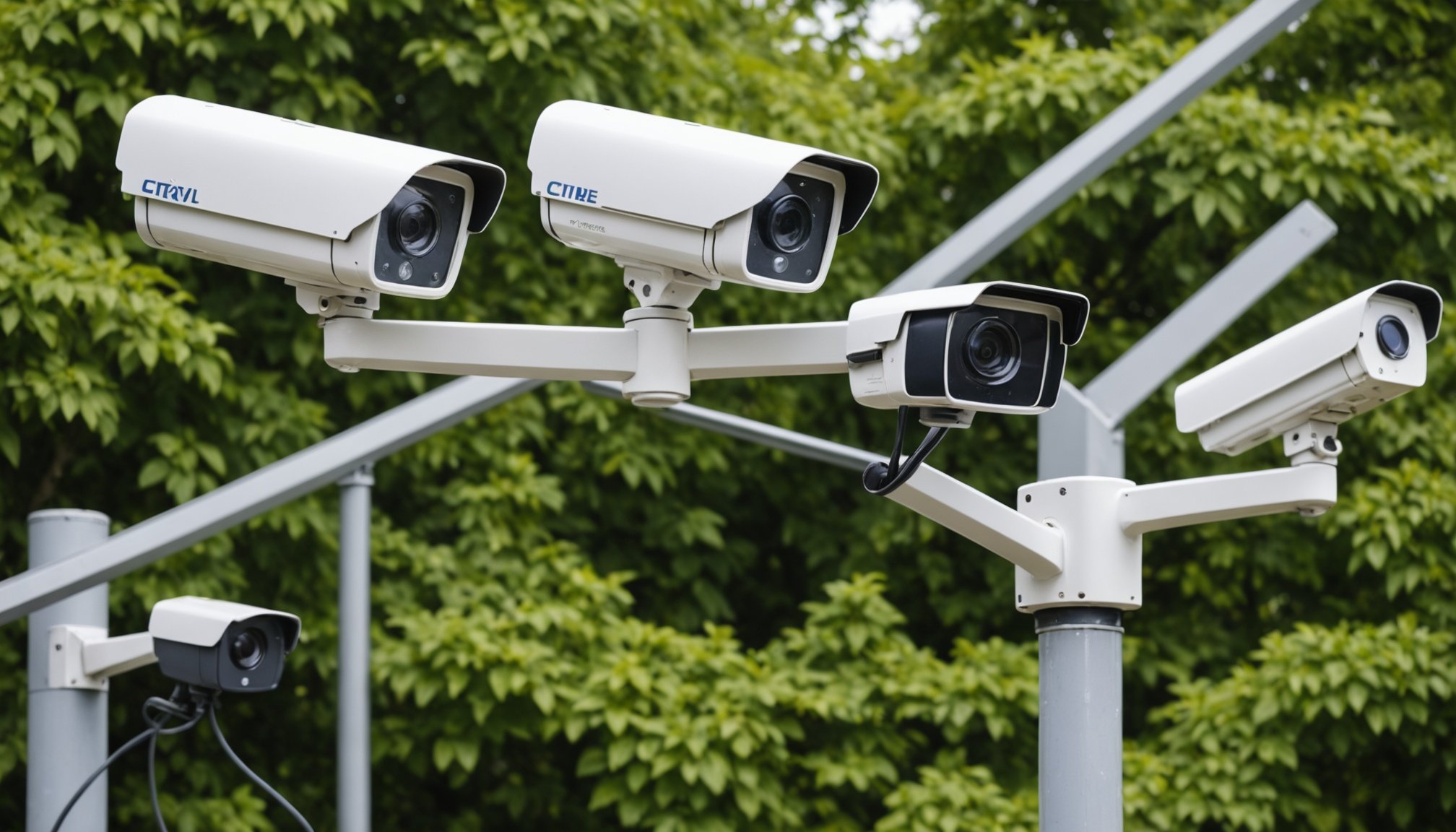Overview of AI-Powered CCTV
AI-powered CCTV systems represent a significant advancement in surveillance technology. These systems integrate artificial intelligence to enhance their functionality and efficiency in monitoring and analysing video footage. Unlike traditional CCTV, which relies heavily on human observation, AI CCTV utilises machine learning algorithms to identify and differentiate between objects, humans, and potential threats. This enables real-time response capabilities and reduces human error.
Recent trends highlight the growing adoption of AI surveillance technology globally. Many urban areas are implementing these systems to deter crime, using their analytical capabilities to provide crime reduction. They can automatically alert authorities to unusual behaviour or unauthorised access, ensuring timely intervention.
Also to see : Revolutionary Advances Transforming Electric Aircraft for Efficient Short-Haul Travel
Crime statistics indicate that certain areas remain vulnerable to criminal activities, with theft and vandalism being common issues. AI-powered CCTV systems have proven effective in these high-risk zones by improving evidence collection and providing actionable insights. They help law enforcement agencies allocate resources strategically, enhancing public safety. The potential of AI CCTV to shape future surveillance and contribute to a safer environment is gaining increasing recognition. As technology progresses, it is anticipated that these systems will further evolve, offering even more sophisticated features.
Case Studies of AI-Powered CCTV Implementation
The deployment of AI surveillance in different community contexts provides revealing insights into its effectiveness. With successful implementations in urban settings, AI-powered CCTV has played a significant role in decreasing crime rates. For instance, in London, integrating AI with existing infrastructure led to a 15% drop in petty crimes over two years.
Also to read : Maximize your reach with quick video promos online
Successful Implementations in Urban Settings
Urban environments, characterized by higher population density and diverse activities, have benefited significantly from AI surveillance. In cities like Barcelona, AI-powered CCTV systems are used to detect unusual behaviour, enabling authorities to respond promptly, thus enhancing public safety. These systems have improved crime statistics, showcasing a drop in incidents requiring police intervention.
Examples from Rural Areas
In contrast, rural areas present unique challenges; however, AI surveillance is proving effective here too. For instance, a community in New South Wales reported a decrease in livestock thefts after installing AI-equipped cameras, an issue previously pervasive and hard to manage.
Analysis of Crime Data Pre- and Post-Installation
Analysing crime data before and after the installation of AI-powered CCTV reveals its transformative impact. In urban areas, reductions in crimes like vandalism and theft are prominently reported. Meanwhile, rural locations show improved response to crimes through better detection capabilities, making communities feel safer and more secure.
Benefits of AI-Powered CCTV on Crime Reduction
AI-powered CCTV systems provide significant benefits of surveillance by acting as a powerful deterrent to criminal activity. By maintaining a visible presence, these systems discourage illegal actions simply by their potential to capture and record criminal behaviour. The deterrence effects are further amplified as advanced technologies enhance detection capabilities, making it increasingly difficult for offenders to evade identification.
Furthermore, AI systems ensure faster response times for law enforcement. With real-time monitoring, these systems can promptly identify suspicious activities and notify the authorities instantly. This not only allows for a quicker reaction but also enables law enforcement to deploy appropriate measures swiftly, which can be crucial in preventing a crime from escalating.
Community safety perception is also significantly enhanced with the presence of AI-driven CCTV. Residents and businesses tend to feel more secure knowing such technologies are in place, contributing to the peace of mind that comes with enhanced public safety measures. Community members are more likely to engage in public spaces when they feel safe, fostering a more vibrant social environment.
To summarize, AI-powered surveillance systems serve as a strong deterrent to crime, assist with rapid law enforcement response, and improve overall community safety, contributing positively to public security.
Potential Drawbacks and Challenges
When it comes to surveillance issues, robot hoovers can raise significant privacy concerns. With the capability to map homes, these devices inadvertently introduce the potential for invasion of privacy. This mapping data could be prone to misuse if not securely protected by manufacturers. Users fear that such valuable information could fall into the wrong hands, or be utilised without consent, leading to fierce debates about the invasion of privacy.
Furthermore, the limitations in technology accuracy and bias present another set of challenges. While cutting-edge, robotics technology isn’t perfect and often grapples with limitations. Misinterpretation of data by these machines can lead to incorrect reporting, creating biases in the way environments are understood and pictured. In extreme cases, this can impact functionalities or lead to restricted performance, failing to meet user expectations.
Additionally, the potential misuse of collected data underscores ethical considerations. Companies might exploit this information for targeted advertising or sell it to third parties, raising severe ethical ramifications. Therefore, understanding these potential drawbacks, alongside thoughtful consideration and implementation of robust privacy measures, is vital for anyone considering these innovative household technologies.
Policy Implications and Regulatory Considerations
Delving into public policy and its intersection with AI, especially in surveillance, reveals a complex landscape. At its heart, surveillance regulations are essential to navigating the challenges and opportunities presented by AI technologies while preserving public trust and safety.
Current Legislation Guiding AI Surveillance
Existing laws often serve as the backbone for implementing these technologies. Their primary focus is ensuring accountability and transparency in the deployment of AI. However, gaps exist due to the rapid pace of technological advancements, necessitating continual updates and adjustments to legislation.
New Laws and Community Standards
Emerging regulations aim to address these gaps, developing community standards that reflect societal norms and expectations. These standards often emphasize ethical considerations, ensuring AI systems align with communal values. Newly proposed laws attempt to foster innovation without compromising individual rights.
Ethical Frameworks for Implementation
The ethical implementation of AI surveillance involves complex considerations. Balancing public safety and civil liberties necessitates robust frameworks that safeguard privacy while providing security. Ethical guidelines should ensure fair usage, preventing discrimination or misuse of surveillance data. These frameworks require constant evolution to remain relevant and protective of both individual and societal interests.
With these components, a responsible approach to AI surveillance can be cultivated, addressing both immediate technical needs and broader societal concerns.
Community Perspectives and Stakeholder Opinions
Understanding the diverse range of views about AI CCTV is crucial to framing its role in society. Public opinion reveals varied sentiments. Many community feedback highlights both support and concerns. Supporters argue AI CCTV enhances safety, citing reduced crime rates as evidence. Detractors, however, question potential privacy infringements and the technology’s possible biases.
Stakeholder analysis presents law enforcement agencies generally favour deploying AI CCTV. They argue these systems are valuable for their ability to efficiently monitor public spaces and quickly identify threats, thus improving response times. However, public opinion suggests a nuanced balance is necessary. Transparency and stringent regulations could foster trust and mitigate worries regarding surveillance overreach.
Conversely, civil rights organizations often voice scepticism, advocating for more restrictive use. Their concerns focus primarily on the ethical implications and the technology’s impact on civil liberties. They push for a framework that ensures the protection of individual rights, emphasizing the need for accountability in algorithmic decisions.
Overall, insights from these varied perspectives underscore the importance of community engagement and a robust regulatory approach. By incorporating broad input, policymakers can refine strategies that address fear of misuse while maximising the benefits AI CCTV can offer.
Future Directions for AI-Powered Surveillance Technologies
In today’s rapidly evolving landscape, AI surveillance technologies are expected to undergo significant advancements. These technologies are crucial in the future of CCTV systems, providing real-time data and analytics to support efficient urban planning. This transformation is particularly pertinent in the context of smart cities, where AI-driven systems are seamlessly integrated to enhance infrastructure, transportation, and public safety.
Technological advancements in AI surveillance are anticipated to bring innovations such as improved facial recognition, predictive analytics, and enhanced cybersecurity measures. These developments will likely lead to more precise and effective crime prevention strategies, ultimately revolutionizing the crime management landscape. The ability to predict and manage incidents before they occur can drastically reduce crime rates and enhance community safety.
As smart city initiatives grow, AI CCTV will play a pivotal role by embedding intelligence into urban environments. Through continuous data collection and analysis, AI can help city planners make informed decisions, optimize resource allocation, and ensure sustainable development. The integration of AI technologies in urban infrastructure not only improves quality of life but also fosters a future of sustainable urbanisation where safety and efficiency are prioritized.











